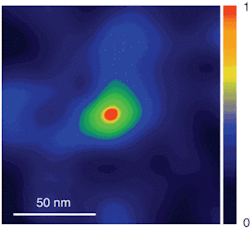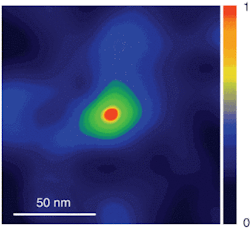Optical nanofountain concentrates light
In standard linear optics, it is impossible to concentrate light by a factor beyond a certain limit that is determined by the properties of the source. For example, even an ideal solar concentrator cannot concentrate sunlight by a factor of more than about 45,000, because the Sun’s finite angular size forbids it. (Thermodynamically, the result is that a solar concentrator can never produce a temperature higher than the 5800°C surface of the Sun.)
For the same reason, the beam quality M2 of a laser beam can never be improved by linear optics; similarly, a far-field microscope objective cannot focus a laser beam to a spot smaller than a certain diameter determined by the numerical aperture, the laser’s wavelength, and the refractive index at the image plane.
Nonlinear systems are different, however. In a diode-pumped solid-state laser, for example, the poor beam quality of laser-diode stacks is converted into the good beam quality of the solid-state-laser emission.
Researchers at the Japan Science and Technology Agency, the National Institute of Information and Communications Technology, the University of Tokyo (all of Tokyo, Japan), and the Tokyo Institute of Technology (Yokohama, Japan) have developed a particularly elegant nonlinear system that concentrates light beyond the linear limit. In it, many quantum dots (QDs) of varying size capture light and pass its energy on to their neighbors, finally unloading it all on a single QD, which reradiates it (see figure).1 The researchers call the phenomenon an “optical nanofountain,” a term inspired by the collecting properties of artesian fountains that are surrounded by water-collecting terrain.
Multistage concentration
When the size ratio of two adjacent QDs is close to 1:√2, the QDs resonate with each other such that virtually all the excitation energy in the smaller one can be transferred to the larger one. If a few different levels of size are larger still, the energy captured by many small QDs can be transferred to a single large QD.
Because deterministically creating the precise size, number, and placement of QDs is difficult, the researchers fabricated a large collection of randomly sized QDs and looked for a subsection of the total area in which the right configuration existed. A 5 × 5-µm region in a sodium chloride matrix was seeded with copper chloride QDs of various sizes, with an average diameter of 4.2 nm and an average separation of less than 20 nm. The assemblage was cooled to 40 K to narrow the resonance of the QDs and prevent interference by thermal activation of excitons.
Light from a 325-nm He-Cd laser was passed through a double-tapered near-field probe ending in a 20-nm-diameter aperture. Scanning the probe across the QD collection and measuring the luminescence wavelength allowed the researchers to locate an optical nanofountain and measure the size and placement of all the QDs around it (smaller and larger QDs luminesce at slightly different wavelengths). They determined that QDs between 2.5 and 4 nm made up the first stage of the optical nanofountain, a smaller number of QDs between 4 and 6 nm made up the second stage, and a lone QD somewhere between 6 and 10 nm made up the final stage. The process was efficient; for a He-Cd laser, the band-to-band excitation that occurred allowed almost all the QDs to be excited, notes Tadashi Kawazoe, one of the researchers.
When compared to that of a similarly sized but isolated QD located elsewhere, the luminescence of the brightly emitting final-stage QD in the optical nanofountain was measured to be five times greater. Pretending for a moment that the system was linear, a calculation of the resulting spot size would result in laser-focusing optics with a numerical aperture of 12, say the researchers.
The one-way concentration process is similar in some ways to what occurs in natural photosynthetic systems, the researchers note. For example, one type of photosynthetic purple bacteria has distinct types of molecules that result in one-way passage and concentration of excitation energy from light.
Uses may include nanoscale resolution microscopes and optical tweezers. “We also propose nanophotonic analog-to-digital and digital-to-analog converters, as well as nano-optical content-addressable memory (CAM),” says Kawazoe. The group has developed a nanoscale data-summation architecture based on the same QD near-field interaction.2 Summation is important in CAM and is useful in optical networks.
REFERENCES
1. T. Kawazoe et al., Applied Physics Lett. 86 103102 (March 7, 2005).
2. M. Naruse et al., Optics Lett. 30(2) (Jan. 15, 2005).

